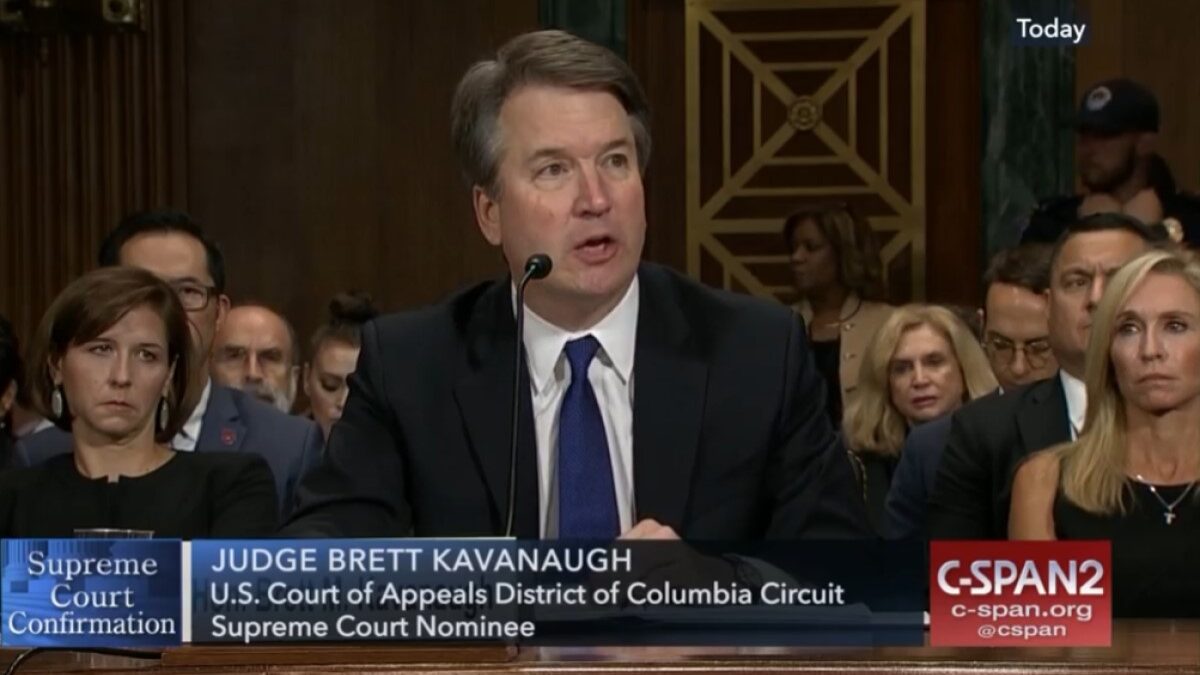This is an excerpt of “The Devil’s Triangle: Mark Judge vs. the New American Stasi,” by Mark Judge, out today from Post Hill Press.
“‘Devil’s Triangle’?”
“Drinking game.”
“How is it played?”
“Three glasses… ever played quarters?
“No.”
“…It’s a quarters game.”
In this exchange can be found the entire dynamic of the train wreck that was the [Supreme Court nominee Brett] Kavanaugh hearing. Rhode Island Sen. Sheldon Whitehouse was certain he had cornered Brett. Because Whitehouse believed the opposition research provided to the Democrats by Michael Avenatti, he believed that Brett and I were involved in gang bangs and drugging girls. When Brett tried to explain the meaning of our silly slang, it was obvious Whitehouse didn’t believe him.
For my part, I had no idea what “the Devil’s Triangle” meant. I had never heard the phrase before. It turned out to be a drinking game that some of my Prep brothers invented during a road trip. However, according to urban lore, the phrase can refer to a sexual threesome including two men and a woman. The oppo hit men accordingly conveyed to the politicians and the media that we had participated in drug-fueled gang rapes, for which we had developed a private code as though we were members of a secret society.
In reality, at least as I am using the term, the Devil’s Triangle denotes a sinister cabal of a different kind: the coordination between opposition researchers, Democratic politicians, and the media.
In “Spooked: The Trump Dossier, Black Cube, and the Rise of Private Spies,” journalist Barry Meier digs deep into this diabolical vortex. “Spooked” is loaded with complex detail, but the point comes down to this: With the rise of political spies and opposition researchers and the demise of reliable gatekeepers like honest reporters and editors, there are no guardrails in the media anymore. Anyone can make an outrageous and unfounded claim about anyone and, without any proof, the story can make it into the media.
Reporters use the information they get from the spies and oppo researchers to publish uncorroborated stories. Without being fact-checked or otherwise vetted, the stories are fed directly into the media bloodstream and from there broadcast to the public. Journalists and political operatives also help create stories that they then report on as if they were observers. They take an active part in manufacturing the stories that they then report as news.
One notable recent result of this corrupt system was the Steele dossier, a piece of garbage cooked up by the Clinton-paid oppo-research firm Fusion GPS. The now-discredited dossier claimed that then-presidential candidate Donald Trump had conspired with the Russians during the 2016 presidential campaign to steal the election. It also claimed that he cavorted with Russian hookers in a Moscow hotel. The media went all in, making fools of themselves over “Russiagate” for four years.
Meier sums it up well: “Investigative journalists normally rely on court records, corporate documents and other tangible pieces of evidence. But the dossier took them down a very different path, one into the shadow lands of intelligence, a realm where documents don’t exist and where reporters often can’t independently confirm what their sources are saying.”
Former FBI director James Comey’s role in getting the Steele dossier story into the media handily illustrates how such things work in Washington. Since being commissioned by Fusion GPS in 2016, the shady and unverifiable document had been peddled to various security and media outlets for months. But none of them would touch it. Comey — an experienced D.C. bureaucratic operator — knew exactly how to get it done.
A 2019 Inspector General’s report would later blast Comey for creating a series of “private” memos of his briefings with Trump, in which he informed the president of the existence of the dossier, and then giving those memos to a friend with instructions to leak them to the media. The result triggered an independent counsel investigation into Trump’s supposed ties with Vladimir Putin.
From USA Today: “Today’s report documents how Comey brazenly violated federal and FBI policies regarding with his disclosures. Top FBI officials told the IG that they were ‘shocked,’ ‘stunned,’ and ‘surprised’ that Comey would leak the contents of one of the memos to a reporter.
The same Stasi-style playbook was used in promoting the Blasey Ford hoax against Brett. The same collection of spies, oppo researchers, and media goons who tried to ruin Trump now used the same tricks on Brett — and me.
On Sept. 12, liberal Intercept reporter Ryan Grim wrote that Dianne Feinstein was arguing with Senate colleagues about whether to release a letter Ford had written to her describing the alleged assault. In his book “We’ve Got People,” Grim describes how reporters themselves helped create the story that they then reported on. “Oftentimes reporters are the mosquitoes that carry the rumor from office to office in attempts to confirm it,” he wrote. On Sept. 7, five days before Grim’s story ran, “several Democrats on the Judiciary Committee learned about it this way.” One of those Democrats was Kamala Harris.
As previously noted, Grim also explained that Ford was no reluctant witness. The argument that Ford didn’t want to testify “ignored that Blasey Ford had already taken repeated steps to come forward, had already told friends she planned to do so, had already come forward to two congressional offices, and reached out to the press, and was only asking for confidentiality until she and Feinstein spoke.”
Ford, her oppo-research operatives, and the mosquitoes in the media had done their jobs. Grim admits as much: “Whether the allegations in the letter were true or not — or, indeed, what the precise allegations were — was its own story, and I didn’t have it. But the fact that Feinstein was battling with fellow Democrats on the committee over the issue was a separate story. And that one I had.” Yes. Because the Feinstein “conflict” story had been manufactured by the press itself.
This is how the Stasi media operates.









